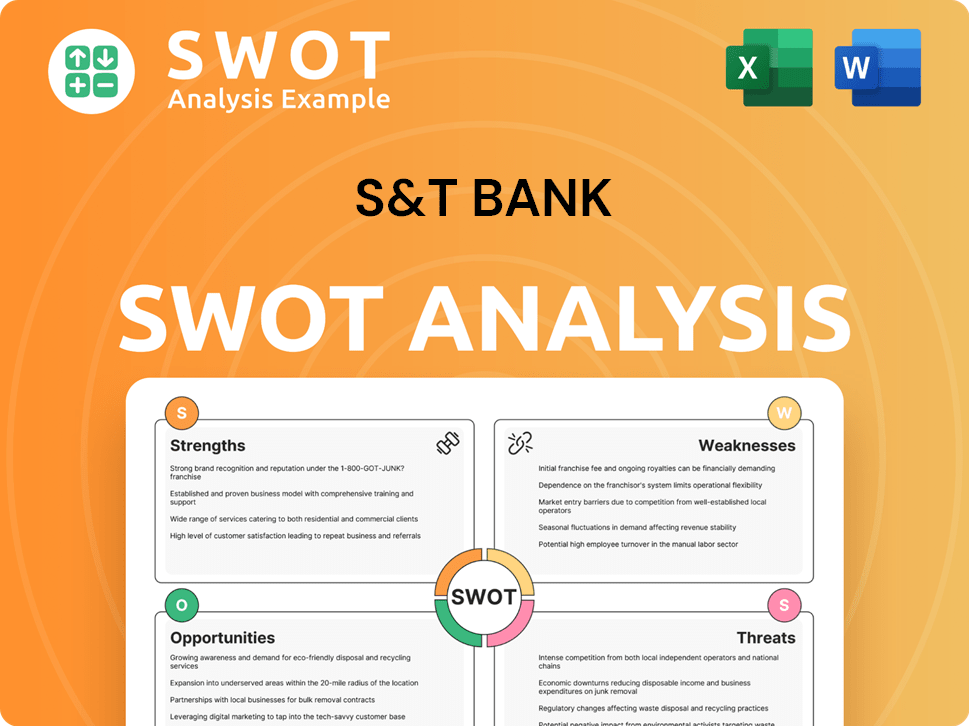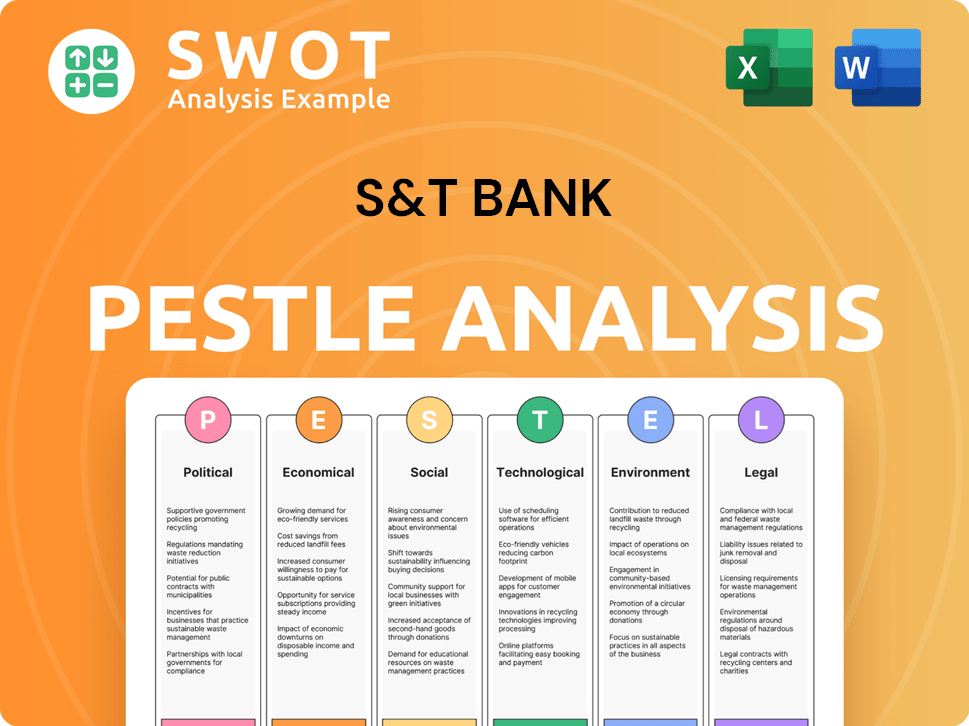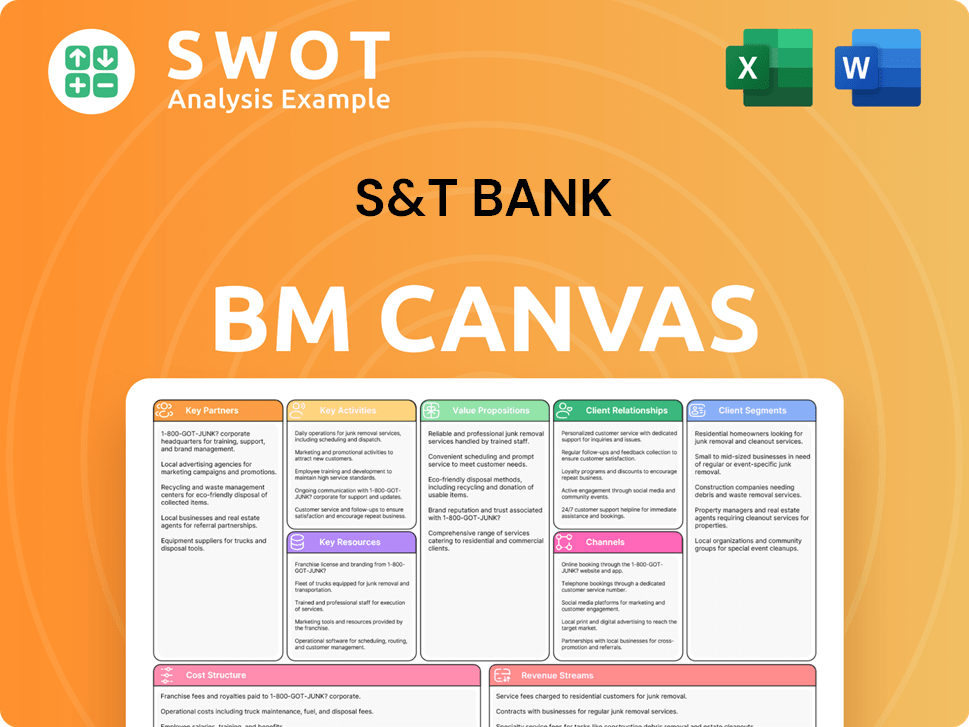S&T Bank Bundle
Can S&T Bank Continue Its Growth Trajectory?
Founded in 1902, S&T Bank has evolved significantly, now serving over 225,000 customers across Pennsylvania, Ohio, and New York. With assets reaching $9.7 billion by the close of 2024, this financial institution's journey from a single branch to a multi-state operation showcases its commitment to strategic expansion. This analysis dives into the core of S&T Bank's S&T Bank SWOT Analysis, exploring its growth strategy and future prospects.

The banking sector's competitive landscape demands a proactive approach, and S&T Bank's 'Our Shared Future' framework is key to its long-term financial performance. This deep dive examines S&T Bank's strategic initiatives, competitive landscape analysis, and market position to understand its potential for future growth. We'll explore S&T Bank's business strategy, including its expansion plans and technological advancements, providing insights into its customer acquisition strategies and overall financial performance.
How Is S&T Bank Expanding Its Reach?
S&T Bancorp is actively pursuing a comprehensive growth strategy, focusing on both organic expansion and strategic acquisitions. This approach aims to strengthen its market position and enhance its financial performance. The company's strategic focus for 2025 and beyond includes growing its deposit franchise and improving its funding mix, reducing reliance on higher-cost borrowings.
The company's strategic priorities for 2025 and beyond include growing its deposit franchise and improving its funding mix by reducing reliance on higher-cost borrowings. S&T aims to leverage its strong capital position to explore strategic investment opportunities and maintain adequate liquidity to support future business operations. This includes a focus on commercial growth, consumer, and retail mortgage activities.
In the fourth quarter of 2024, S&T's loan growth improved. Expanding loan pipelines position the company for better results in 2025. S&T also emphasizes growing its wallet share with existing customers through enhanced product capabilities and proactive outreach. Furthermore, the company is committed to community development, providing over $15.5 million in community development loans across its footprint in 2024.
S&T Bank primarily operates in Pennsylvania and Ohio, with operations extending into New York. The company is open to inorganic growth opportunities, particularly in contiguous states. This strategic approach allows for controlled expansion and market penetration.
S&T is focused on enhancing product capabilities to grow its wallet share with existing customers. This includes expanding digital banking services and offering competitive financial products. These initiatives are designed to increase customer loyalty and attract new clients.
S&T Bank is committed to community development, providing over $15.5 million in community development loans across its footprint in 2024. This includes funding 158 loans under the Home Ownership Program. The bank's participation in FHLBank Pittsburgh's First Front Door grant program further supports first-time homebuyers.
The company aims to leverage its strong capital position to explore strategic investment opportunities and maintain adequate liquidity. The focus will be on commercial growth, consumer, and retail mortgage activities. This strategic approach is designed to enhance S&T Bank's financial performance and market position.
S&T Bank's expansion strategy includes organic growth within its existing markets and opportunistic market expansion. The company is also open to potential acquisitions to accelerate growth. These strategies are supported by a focus on customer acquisition and digital banking services.
- Organic Growth: Expanding within Pennsylvania, Ohio, and New York.
- Strategic Acquisitions: Exploring opportunities in contiguous states.
- Product Development: Enhancing digital banking and financial products.
- Community Involvement: Investing in community development projects.
S&T Bank SWOT Analysis
- Complete SWOT Breakdown
- Fully Customizable
- Editable in Excel & Word
- Professional Formatting
- Investor-Ready Format

How Does S&T Bank Invest in Innovation?
S&T Bancorp recognizes the importance of technology and innovation in maintaining a competitive edge within the financial services sector. The banking industry is undergoing a digital transformation, with institutions increasingly relying on technology to boost efficiency, improve customer experiences, and secure their market positions. The company's strategic framework, 'Our Shared Future,' emphasizes profitable growth, which includes a focus on leveraging technology to deliver financial products and services effectively.
While specific details on S&T's research and development investments or key patents are not extensively detailed in publicly available information, the broader banking industry is seeing significant investments in areas like artificial intelligence (AI), the Internet of Things (IoT), and automation. These investments aim to reinvent customer journeys, accelerate speed to market, and drive operational efficiencies. S&T's commitment to digital transformation is evident in the broader trend of financial institutions adopting AI-driven automation for fraud detection, risk analysis, and customer service.
In 2024, S&T employees logged approximately 77,290 training hours, averaging 64 hours per employee, indicating an investment in human capital to adapt to evolving industry needs. The company's emphasis on personalized banking and local decision-making also suggests a blend of traditional service with modern efficiency, likely supported by technological advancements. For a deeper understanding of S&T Bank's foundational principles, consider reading about the Mission, Vision & Core Values of S&T Bank.
S&T Bank offers a range of digital banking services, including online and mobile banking platforms. These platforms allow customers to manage accounts, make transactions, and access financial information conveniently.
The bank likely uses AI and automation in various areas, such as fraud detection and customer service. These technologies help improve efficiency and enhance the customer experience.
Data analytics is used to gain insights into customer behavior and market trends. This data helps the bank make informed decisions about product development and service offerings.
Cybersecurity is a critical focus, with the bank investing in measures to protect customer data and prevent cyber threats. This includes regular security audits and employee training.
The bank may utilize cloud computing for data storage, application hosting, and other services. This helps improve scalability and reduce IT costs.
S&T Bank likely supports mobile payment options, allowing customers to make payments using their smartphones or other mobile devices. This enhances convenience and customer satisfaction.
S&T Bank's technology strategy likely includes several key areas of focus. These advancements are essential for maintaining a competitive edge and meeting evolving customer expectations. The bank's commitment to innovation is reflected in its investment in digital infrastructure and employee training.
- Digital Transformation: Implementing digital solutions to enhance customer experiences and streamline operations.
- Data Analytics: Utilizing data to gain insights into customer behavior and market trends for better decision-making.
- Cybersecurity: Investing in robust cybersecurity measures to protect customer data and prevent fraud.
- Cloud Computing: Leveraging cloud services for scalability, cost efficiency, and improved data management.
- Automation: Employing automation technologies to improve efficiency in various banking processes.
S&T Bank PESTLE Analysis
- Covers All 6 PESTLE Categories
- No Research Needed – Save Hours of Work
- Built by Experts, Trusted by Consultants
- Instant Download, Ready to Use
- 100% Editable, Fully Customizable

What Is S&T Bank’s Growth Forecast?
In 2024, Owners & Shareholders of S&T Bank saw a strong financial performance. The company demonstrated solid return metrics, with a return on average assets (ROA) of 1.37%, return on average equity (ROE) of 9.86%, and return on average tangible equity (ROTE) (non-GAAP) of 13.84%. This performance reflects the bank's ability to generate profits efficiently and manage its assets effectively.
The bank's net income for 2024 was $131.3 million, with diluted earnings per share (EPS) at $3.41. While this was slightly lower than the record net income of $144.8 million and EPS of $3.74 in 2023, the 2023 figures were significantly impacted by rising interest rates. This slight decrease highlights the impact of external economic factors on the company's profitability.
Net interest income decreased by 4.18% to $334.8 million in 2024. The decrease was primarily due to the impact of higher interest rates on funding costs. Despite this, the bank managed to maintain a strong financial position, indicating effective cost management and strategic financial planning.
S&T Bancorp anticipates net interest margin to stabilize with minimal compression in 2025. This suggests the bank expects to manage its interest rate sensitivity effectively. This stability is crucial for maintaining profitability in a fluctuating interest rate environment.
The company sees opportunities for deposit growth within its existing customer base. This focus on organic growth indicates a strategy to leverage current customer relationships. This approach can lead to sustainable growth and reduced customer acquisition costs.
S&T Bancorp is positioned for better loan growth in 2025, supported by expanding loan pipelines. This indicates the bank's proactive approach to increase its loan portfolio. Increased lending activity is a key driver of revenue growth for the bank.
Total assets were $9.7 billion at the end of 2024 and March 31, 2025. Total portfolio loans increased by $53.9 million, or 2.79% annualized, in the fourth quarter of 2024 compared to the third quarter of 2024, with growth in residential mortgages and commercial real estate. This shows the bank's ability to grow its loan book, particularly in key areas.
S&T maintains a strong regulatory capital position, with all capital ratios above the well-capitalized thresholds of federal bank regulatory agencies. The board approved a $0.34 per share cash dividend on January 29, 2025, an increase of $0.01 or 3.03% compared to the prior year. This demonstrates the bank's financial health and commitment to returning value to shareholders.
- Strong Capital Ratios: Above well-capitalized thresholds.
- Dividend Increase: $0.34 per share, up 3.03% from the previous year.
- Financial Stability: Reflects a robust financial position.
- Shareholder Value: Commitment to returning value to shareholders.
S&T Bank Business Model Canvas
- Complete 9-Block Business Model Canvas
- Effortlessly Communicate Your Business Strategy
- Investor-Ready BMC Format
- 100% Editable and Customizable
- Clear and Structured Layout

What Risks Could Slow S&T Bank’s Growth?
Several risks and obstacles could affect the growth strategy and future prospects of S&T Bancorp. These challenges include intense competition from various financial service providers and the constant need to adapt to regulatory changes. Understanding these potential hurdles is crucial for a comprehensive S&T Bank company analysis.
The company must navigate the evolving financial landscape, including technological disruptions and economic uncertainties. S&T Bank's financial performance and market position are directly influenced by its ability to manage these risks effectively. This requires strategic initiatives and robust risk management strategies.
Commercial real estate (CRE) exposure presents a notable risk. The company's loan portfolio analysis indicates a focus on managing CRE-related challenges. S&T Bank's strategic initiatives for 2024 and beyond must consider the impact of interest rates and potential shifts in the market.
S&T Bank faces competition from traditional banks, credit unions, and fintech companies. Some competitors may operate with lower cost structures. This competitive environment requires S&T Bank to continuously refine its business strategy.
S&T Bank is subject to federal and state regulations. Changes in these regulations, particularly those related to consumer protection, can significantly impact the banking industry. New SEC rules on cybersecurity incident disclosure, effective in late 2023, exemplify this ongoing challenge.
CRE exposure, especially construction loans, poses a risk to asset quality. S&P Global revised S&T Bank's outlook to negative in August 2023 due to heightened CRE exposure. Rising interest rates and lower occupancy rates can weigh on property values and borrower cash flows.
Technological advancements can lead to new forms of fraud and scams. This requires continuous updates to internal control information systems. S&T Bank must invest in technological advancements to stay competitive.
Supply chain vulnerabilities, encompassing cyber risks, economic risks, and geopolitical events, can impact operations and profitability. While not detailed for S&T, this is a general concern for businesses in 2025. S&T Bank's risk management strategies must address these issues.
The FDIC's 2025 Risk Review highlights interest rate uncertainty as a market risk. Elevated unrealized losses on bank securities portfolios are also a concern. The impact of interest rates on S&T Bank's loan portfolio analysis is crucial.
S&T Bank's Asset and Liability Committee (ALCO) oversees interest rate and liquidity risks. The company maintains a strong capital position and access to contingent funding sources. A key aspect of Revenue Streams & Business Model of S&T Bank is its approach to risk management.
A significant volume of CRE loans is scheduled to mature in 2025. These loans could face difficulties due to elevated interest rates. This requires careful monitoring of the loan portfolio to mitigate potential losses.
The competitive landscape includes local, regional, and national financial service providers. S&T Bank must differentiate itself through customer acquisition strategies and digital banking services. Analyzing the competitive landscape is vital for S&T Bank's future prospects.
Technological advancements are a continuous threat, requiring continuous updates to internal control information systems. S&T Bank must invest in digital banking services and technological advancements to stay competitive. This includes addressing the potential for new forms of fraud.
S&T Bank Porter's Five Forces Analysis
- Covers All 5 Competitive Forces in Detail
- Structured for Consultants, Students, and Founders
- 100% Editable in Microsoft Word & Excel
- Instant Digital Download – Use Immediately
- Compatible with Mac & PC – Fully Unlocked

Related Blogs
- What are Mission Vision & Core Values of S&T Bank Company?
- What is Competitive Landscape of S&T Bank Company?
- How Does S&T Bank Company Work?
- What is Sales and Marketing Strategy of S&T Bank Company?
- What is Brief History of S&T Bank Company?
- Who Owns S&T Bank Company?
- What is Customer Demographics and Target Market of S&T Bank Company?
Disclaimer
All information, articles, and product details provided on this website are for general informational and educational purposes only. We do not claim any ownership over, nor do we intend to infringe upon, any trademarks, copyrights, logos, brand names, or other intellectual property mentioned or depicted on this site. Such intellectual property remains the property of its respective owners, and any references here are made solely for identification or informational purposes, without implying any affiliation, endorsement, or partnership.
We make no representations or warranties, express or implied, regarding the accuracy, completeness, or suitability of any content or products presented. Nothing on this website should be construed as legal, tax, investment, financial, medical, or other professional advice. In addition, no part of this site—including articles or product references—constitutes a solicitation, recommendation, endorsement, advertisement, or offer to buy or sell any securities, franchises, or other financial instruments, particularly in jurisdictions where such activity would be unlawful.
All content is of a general nature and may not address the specific circumstances of any individual or entity. It is not a substitute for professional advice or services. Any actions you take based on the information provided here are strictly at your own risk. You accept full responsibility for any decisions or outcomes arising from your use of this website and agree to release us from any liability in connection with your use of, or reliance upon, the content or products found herein.